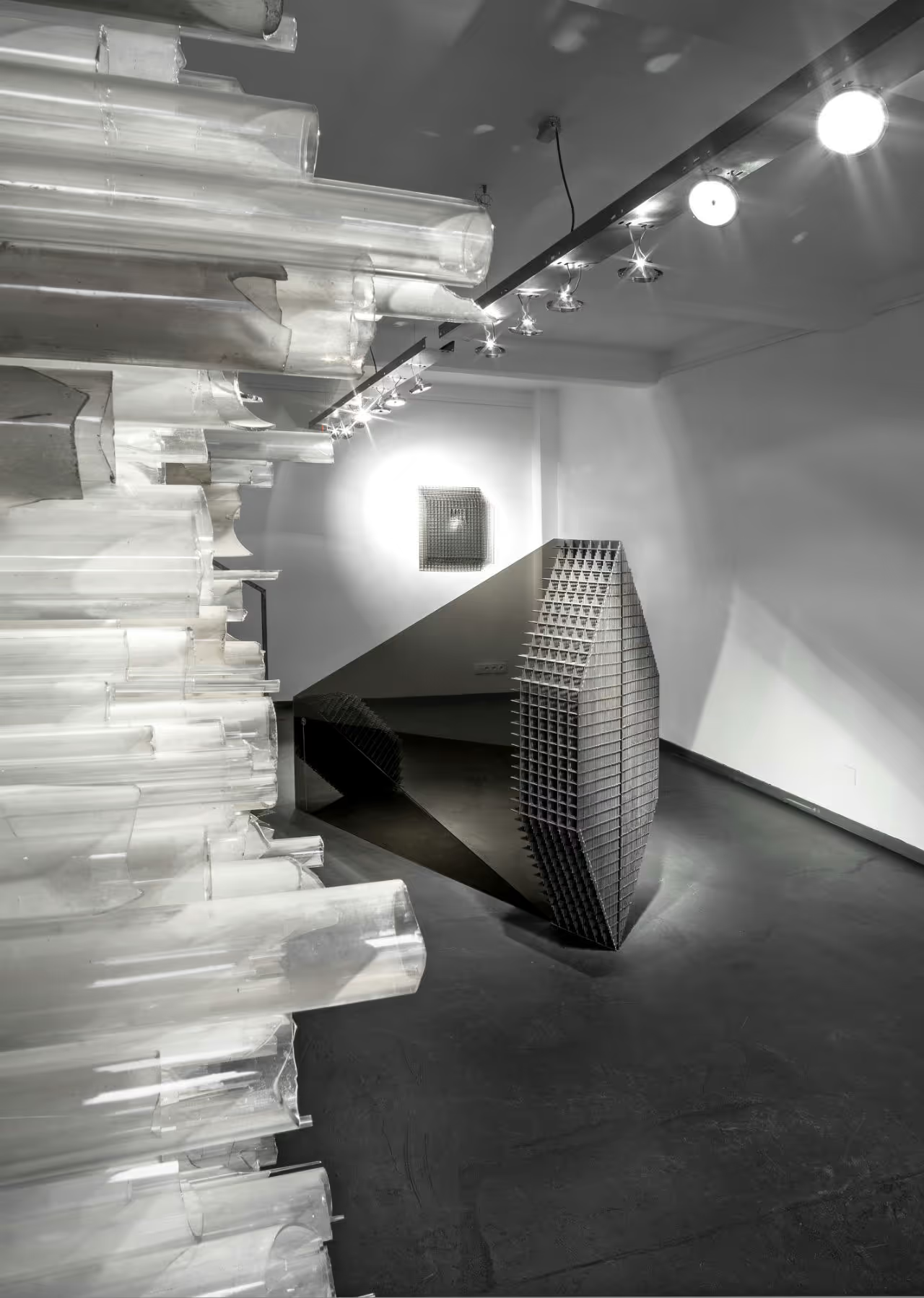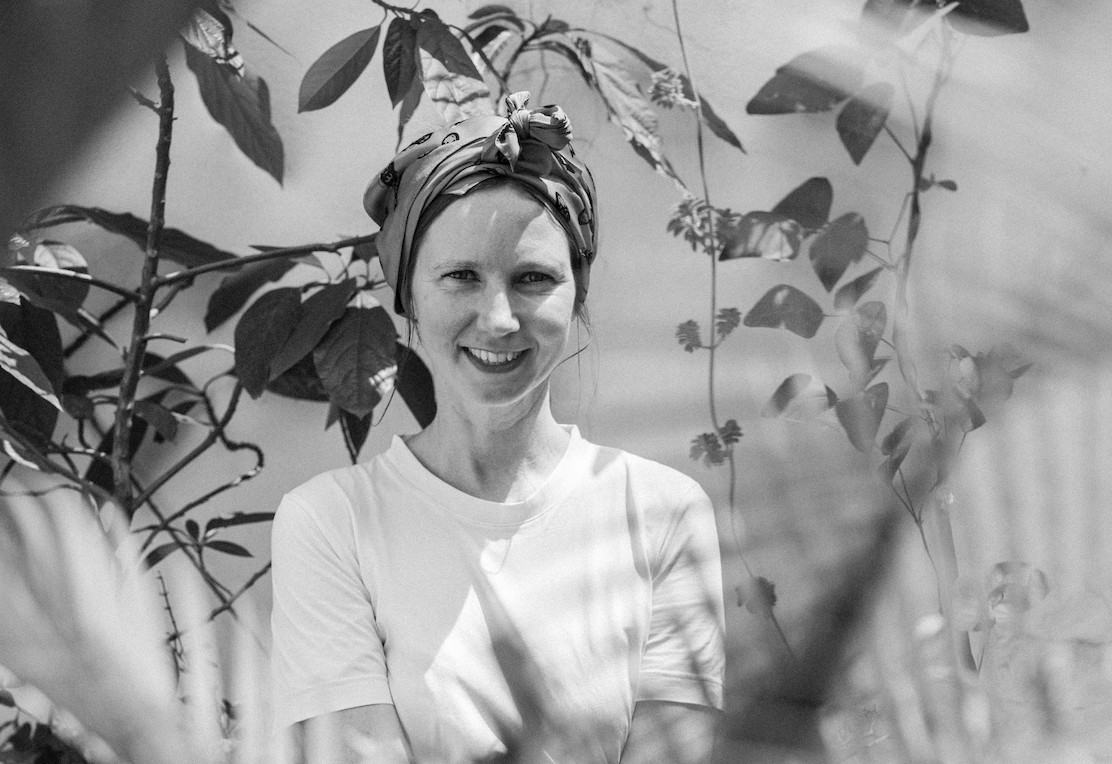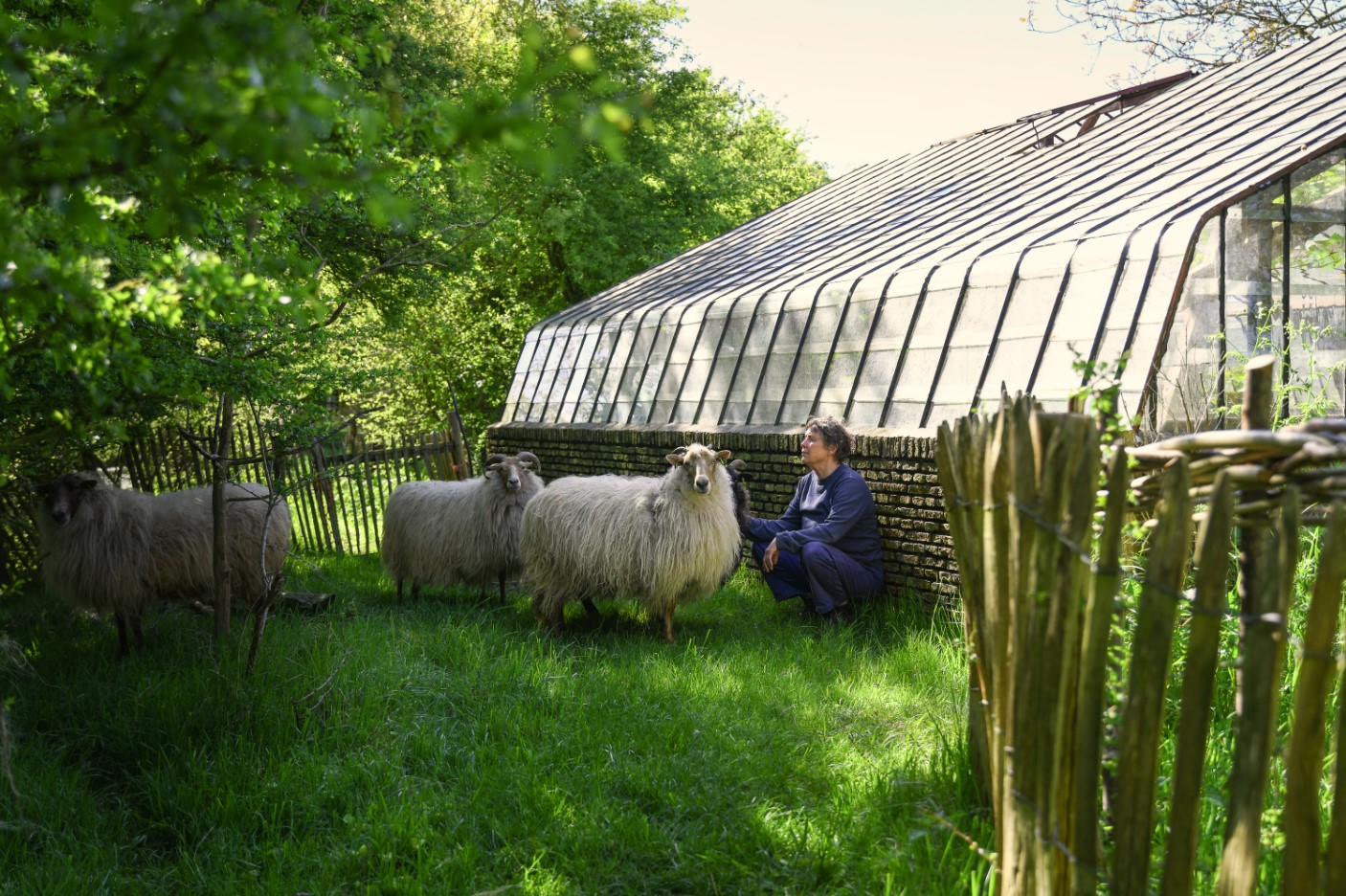► českou verzi článku najdete zde
Two factors likely play a major role in the remarkable diversity of Petr Stanický’s artistic output. For one, sheer talent; and secondly, the times in which he began to present his art to the world. For the Czech fine art scene was passing through its post-modern phase, pushing aside the hitherto dominant innovative position of modernism. When Petr Stanický was ending his university studies, even the premises of postmodernism were themselves losing their foothold – both around the world and in the Czech Republic – in terms of representing the defining contours of the fine art scene.
Western civilisation has found itself in a period of “liquid modernity” according to sociologist and philosopher Zygmunt Bauman. Now, not only could one turn anywhere for inspiration – or seek out creative sources anywhere, and interpret them in any way one wished – but one no longer needed (or perhaps was it even desirable) to view artworks as a way to uncover meaning in the world, or as representing quests probing a deeper understanding of existence. It would appear that this era is not actively searching, and its desire to seek out the figurative vanishing point continues to diminish. Only strong, and firmly anchored talents can stand the test in this era of “liquid modernity”.
Petr Stanický began his studies at the Academy of Arts, Architecture and Design in Prague (AAAD) in 1990. He studied sculpture under Professor Kurt Gebauer, a member of the “Volné seskupení 12/15 Pozdě, ale přece” free art group, which serves as a collective of notable figures in the Czech fine art community who entered the scene during the 1970s. Kurt Gebauer is an artist, whose works never clung to existing forms. Undoubtedly, this is something that strongly inspired Stanický. Such an ability – to not adhere to what has already been uncovered, and to be open and receptive to what has yet to be uncovered – continues to accompany his work to this day. Stanický subsequently studied Glass in Architecture under Professor Marian Karel, also at VŠUP. This cultivated a sense for searching out the ingrained order of things; a sense for clearly defining artistic concepts through a firm structure; and utilising modest, even minimalist, means.
Without question, his meeting with the multifaceted, lively and inspirational sculptor Jiří Beránek was a crucial moment for Petr Stanický. Beránek is among the most important artists of the Kurt Gebauer generation. With his extensive works, Jiří Beránek managed to touch many of the proverbial bases of spatial design. In particular via his efforts with wood. His work with this age-old sculpting material showed Beránek to be a remarkably sensitive artist, with a distinctive character, and one who has influenced a whole series of other artists. Even during his studies, Petr Stanický collaborated with Jiří Beránek on a number of spatial-themed projects. Following several years spent on study trips in the United States, Stanický returned to Beránek’s Sochařství II (Sculpture II) studio at AAAD, serving as a teacher there from 2003-07.
From the outset, Petr Stanický’s work as an independent artist celebrated notions surrounding the enjoyment of one’s domestic spiritual space. This incorporated both facets of contemporary art as well as also being anchored in overarching and unchanging historical narratives. And such narratives are well-understood by Stanický, who interprets his own artistic output with a comprehensive understanding of various artistic manifestations spanning locations with entirely variegated cultural and, chiefly artistic, traditions.
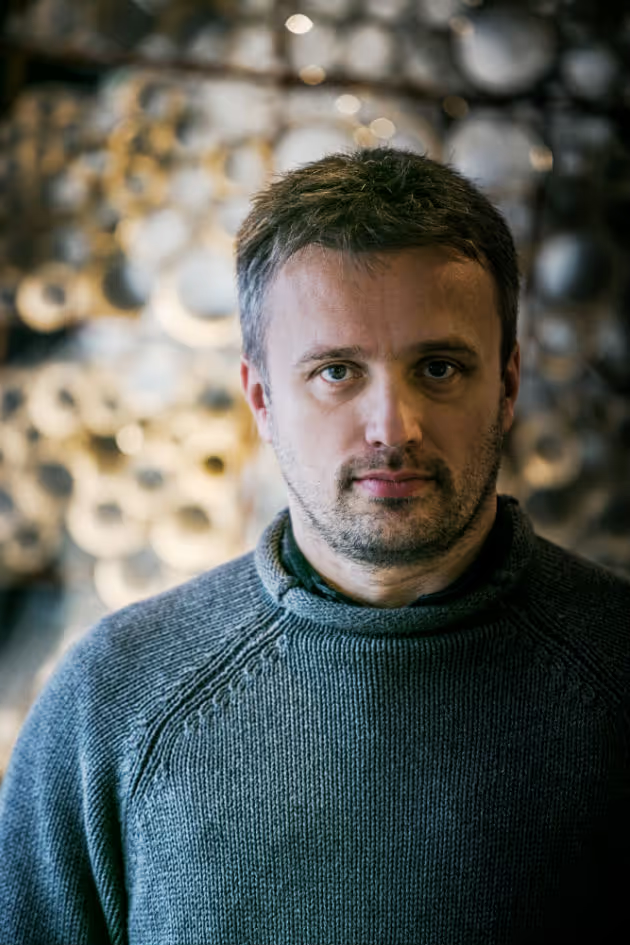
Petr Stanický (born 1975) studied with Kurt Gebauer and Marian Karel at the Academy of Arts, Architecture and Design in Prague from 1990-2000. Further experiences were gained via the glass studio at the Edinburgh College of Art, and also later at the US Rhode Island School of Design. From 2005-07, Stanický took a postgraduate course at the New York Academy of Art.
From 1995-2000 he collaborated on sculpture projects by Olbram Zoubek and Jiří Beránek. Starting in 2003, he spent four years as a teacher at the VŠUP studio of Jiří Beránek. After that he spent a year as a sculptures project assistant at the New York-based Jeff Koons Studio. In 2008, he joined the Tomas Bata University in Zlín (UTB) as head of the Glass Design studio. From 2010-2013, Stanický also served as director of the UTB’s Institute of Product and Spatial Design within the Faculty of Multimedia Communications.
Petr Stanický utilises a variety of materials in his works – wood, metal, various permutations of glass, and even polystyrene. Very often all such materials are found in a particular work. Whatever materials he chooses, Stanický is not guided by external preconceptions about the way things should, or should not, be done. The author’s sharp perception and individualistic usage of chosen materials serves to create entirely authentic works.
Despite mostly being listed as a glass sculptor, Stanický’s artistic sensibilities are better described under the simple banner of “sculptor” – albeit one who very often utilises various forms of glass in his works. His series of mostly smaller-sized wooden sculptures are also not to be overlooked. Despite their size, the works nonetheless boast traits of monumentality. In particular, these can be found in the likes of Velké nároží (Large Corner, 2004), whose sense of power evokes a kind of primal holy place. Even though Velké nároží is not a figuration, it nonetheless possesses a corporeal quality and the impression of a human presence. Marking a location with an artwork naturally means ensuring the work is visible – and that entails generating something that stands out from the eternal realms of space. It’s an ancient human gesture by which Man seeks to understand his place amidst the endless noise-filled and often frightening eddies and currents of space and time. The geometric shapes expressed in the relatively small wooden sculpture Dvojčata (Twins, 2005), evidently serves as an evocation of the artist’s time in the US. Yet it also radiates a sense of an ancient domestic idol. Such American reminiscences are also undoubtedly on display in the entire “Metropolis” series, produced between 2000-2005.
Druhé patro (Second Storey) came about back in 2000. It is a sculpture which demonstrates Stanický’s unorthodox work with glass – he merges it will metal and other materials to evoke dimensionality. The end effect is a spatial representation that is not fixed, but rather presents a sense of change inseparably anchored to the movements of time. A similar sense of a celebration of the mysteries of time and space can be found in other works. These include Stín architektury (The Shadows of Architecture, 2002), Osada (Settlement, 2002), Mrazení (Chill, 2004), and also Stanický’s enigmatic story – one highly expressive in a painter’s sense – Noční město (City at Night, 2008–2009).
2011 saw the creation of the work Tovární budova I (Factory Building I), in which Petr Stanický once again merged glass and metal. Both of these materials are prefabricated. Yet in Stanický’s hands they served as building blocks for a puristically clean work, which undoubtedly reflects the architecture of the city of Zlín. A dense lattice winds its way along a shallow curve, and is covered in places by semi-transparent glass. The work is also layered with entirely flat panels of glass. It can be viewed as a spatial drawing, with a fleeting fragility; or as a fragment of an architectural bozzetto, whose end form remains concealed from the observer.
Tovární budova II (Factory Building II), also from 2011, works along a similar principle. In this case, a metal mesh serves as a kind of fundament, with matted glass surfaces looming above. Asides from such works, which utilise sheet glass and prefabricated metal grates, a piece going under the name of 21 is also worth a mention. This large work is over two metres tall and is also comprised of sheet glass and metal grating. All of these works resemble buildings in miniature – products of human rationality, which do not make use of refined materials, and which largely give off an impression of lacking mass and of impenetrability, and in which the chief role of spiritual value is given over to light itself.

The Glass Space exhibition was held at the Galerie Kuzebauch from December 16 to February 28, 2017. The gallery is located at Říčanova 19 in Prague (photo: Gabriel Urbánek)
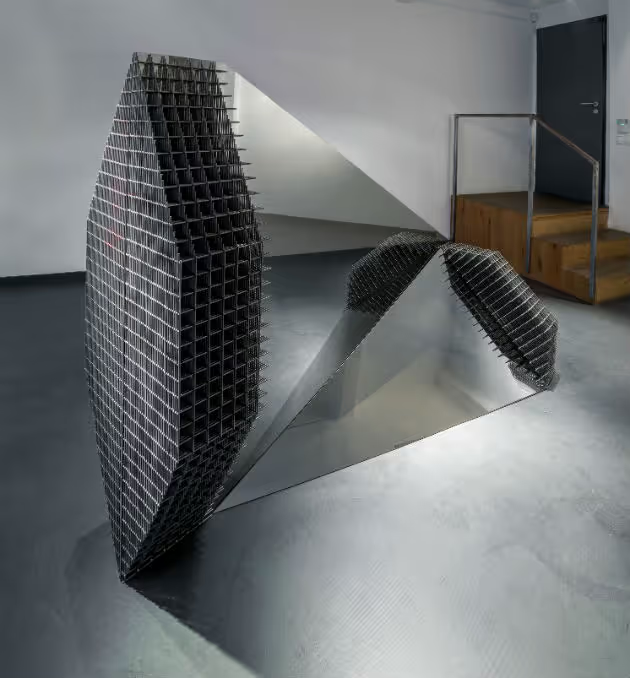
Útočiště II (Refuge), glass and metal, 2015 (photo: Gabriel Urbánek)
Five works spanning the past three years were placed on display by the author in a relatively small, rectangular white space at the Galerie Kuzebauch, which is operated by Happy Materials. Útočiště II (Refuge, 2015), which once again fuses glass and metal, dominated the middle of the room. The front of the work is comprised of two three-dimensional, multi-sided structures of differing height. Two large pieces of triangular sheet glass, both different in size, are placed between these two structures. These glass sheets are connected along the longest point, forming an obtuse angle. The outer structures are comprised of dense metal lattices, evidently prefabricated building materials. Despite this, the work radiates an ethereal quality, as if they were models of the interior structures of matter.
“Despite its appearance of solidity, the familiar world was actually no more substantial than a ghost. Matter, whether in the form of a chair, a human being, or a star, was almost exclusively empty space…,” writes author Marcus Chown in Quantum Theory Cannot Hurt You. The surfaces of glass placed between these two metal structures reflect events around them in a kind of fragmented manner. Observers passing by see a world of fragments, which can only be grasped in motion – meaning through time. Is Man really fated to only see reality in reflections, mirror images, and the shadows of a Platonic cave?

Prostup (Permeation), glass and metal, 2016 (photo: Gabriel Urbánek)
A cubic figure of infirm consistency emerges starkly from a door-like opening. In the sculpture Prostup (Permeation, 2016) Petr Stanický once again utilises entirely ordinary building materials, in this case of the consumer kind. The work uses glass tubing of various diameters, and metal construction rods (rebars) welded into a kind of storage stand. While surveying this work – which at first gives the appearance of a dump site – observers can ultimately look head-on and realise that it creates a sense of unease with its various protruding bits of broken-off pipes. Something potentially dangerous has been here...

V kostce (In a Cube), glass and metal, 2013 (photo: Gabriel Urbánek)
Sitting quietly and inconspicuously by the back wall of the gallery was another artwork – a relief entitled V kostce (In a Cube, 2013). It is comprised of around ten layers of a light metal mesh, with its dimensions expanding towards the direction of the wall. The front is formed of a flat piece of glass containing a cut-out four-sided orifice in the middle. The transparent structure of the piece seems to suggest that nothing is being concealed from the observer; that it is only a rational construction comprising no deeper mystery. And yet it cannot help but evoke an old Gothic reliquary, which did indeed conceal a secret –the secret of holiness.
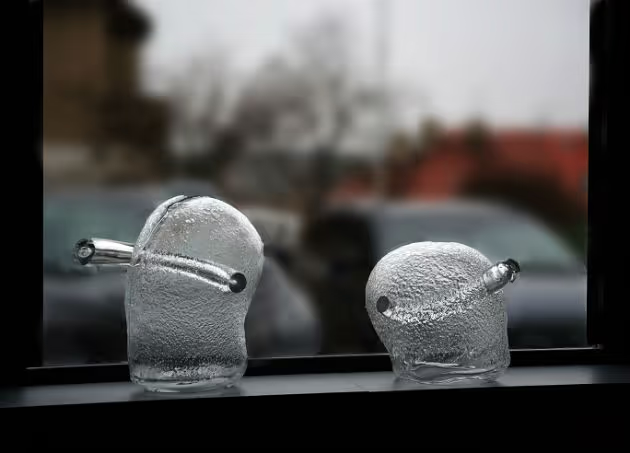
Hlava (Head), blown glass, 2013; and Vanitas, blown glass, 2012 (photo: Gabriel Urbánek)
Two glass sculptures on a gallery windowsill underscored another facet of the work of Petr Stanický, namely utilising molten glass as its own exclusive material. Two shapes, evidently human heads, are formed of an outer shell of transparent glass. But the heads lack facial features. One piece carries a very timely name – Vanitas (2012). Does today’s society even react to such a word anymore?
Through his works, Petr Stanický is seeking to shake-up a world which characterises itself as clear, comprehensible, and posing no profound questions. The artist’s work is able to open up doors of perception, unveiling still unanswered deeper secrets affecting all of our realities.

Ivan Neumann graduated in Art History from the Philosophical Faculty at Charles University in Prague. He later defended his doctoral thesis at the same university. He has worked in the Alšova jihočeská galerie in the town of Hluboká nad Vltavou, at the National Gallery in Prague, at the ČMVU. He served as director of the ČMVU from 2000; from 2004-2009, while director of the ČMVU, he headed a team working on the reconstruction and establishment of the The Kutná Hora Arts Centre on the site of a former Jesuit College. From 2009 he spent two years as head of the Villa Pellé cultural and social centre in Prague 6. He is a member of numerous gallery acquisitions boards. He has designed many exhibitions of contemporary fine art both in the Czech Republic and abroad. He regularly publishes articles and reviews and is the author of a number of monograph publications.
Photo of Petr Stanický: Tomáš Rubín; photo of Ivan Neumann: NoJin, CC BY-SA 3.0, Wikimedia Commons, Translated by Dominik Jun
